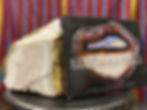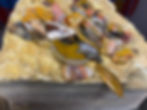The Kentucky Agate Affair
- Rachel Savane
- Oct 2, 2021
- 5 min read
My hands were full of goodies from the indoor farmers market, so the Asian lily farmer kindly carried my cut stems up to the second floor of the downtown mall called Victorian Square. I had recently opened my first ever shop called Savané Silver, a gallery featuring only my own jewelry designs. This move a brick and mortar location was my answer to art fairs, but permanent, rather than several weekends a year. The lily farmer looked around and said “I've got to tell Rolly about this.” I asked to whom he referred and he said his buddy at the farmer’s market deals in Kentucky agate. I had heard of the agates of Kentucky, but to date I had only seen a few in the possession of an art fair buddy of mine. "So-so" had been my reaction to the yellowish and brown stone. I was actually a little disappointed because I thought it would be cool if there were a gemstone from right around me that I could use in my silver designs.
The following week he walked in, glanced around and started talking. He talked about secret societies and the closed nature of Eastern Kentucky since coal was discovered there and the lifestyle of self-sustaining communities changed forever and not for the better… As he rambled on, I finally interrupted this fairly annoying rant and asked, “Are you going to show me some agate or what?” He had brought maybe 15 gemstones with him. They did not impress me. Colors were light butterscotch or whitish, some dark brown. I thought I would humor him and purchase a couple pieces, just to be nice. He was holding back the amazing array of stones until a later meeting, perhaps deciding if he thought I was worthy.
His name is Roland McIntosh and he has recently authored the first book about Kentucky Agate entitled Kentucky Agate: State Rock and Mineral Treasure of the Commonwealth.

Back when we met in the early 2000’s, he had decided to make as much effort as he could to get the word out about this amazing rock, ahem, mineral. He had been met with opposition from people who knew about agate, hunted agate and cut and polished agate. It is found only in a few counties of the 120 counties in Kentucky. It is in the eastern part of the state where people have been traditionally averse to inviting outsiders to come see what’s going on there. He had decided to defy the locals of whom he was one, and set out to let it be known that an amazingly beautiful mineral exists in Kentucky.
Shortly after our first meeting, Roland embarked on setting up a display at the Central Library in Lexington, KY. The display remained for six months and included uncut agate geodes, single cut agate specimens displaying the interior of the agate geode, slabs of agate, cabochons of agate and my silver jewelry featuring agate. Our friendship grew rapidly and exponentially after that first meeting. He showed me more of the glorious colors and patterns found in the agates of Kentucky and I purchased more and more cabochons from him. Some barter fun happened since he was wishing for some of his most special gemstones to be made wearable.

Roland has been selling agate specimens, slabs and cabochons at the farmer’s market for years having convinced the board that it is indeed Kentucky grown. He took geology professors on a field trip and showed them where in the strata it had formed. They rewrote the story of the agates of Kentucky with information proving that it was formed in the area rather than farther north and pushed south by glaciers. Glaciers! The formation of it is in the range of 350 million years ago. According to Roland, scientists do not know how agate geodes formed, whether from the inside out or from the hull first and then solidifying the interior. They cannot explain how banding forms or why it occurs. Ultimately, man can not recreate agate. There are manmade sapphires, rubies, emeralds, opals and diamonds, but there may never be a lab created agate. As a purist of natural objects, this pleases me. Alexandrite is another lab grown gemstone and now I have to disclose fully that I own one of them. Alexandrite is fascinating in that it changes color depending on the light source. Sunlight is one color, incandescent another, fluorescent another and I guess halogen or led have their own effect on alexandrite too. Generally speaking I am only interested in gemstones of the earth, but I have made a single exception. Skrrrrrr, back to agate. I love the fact that this gem is full of mystery as to its formation. Mysterious in formation and even harder to find at all.

There is no mining of agate. The geodes are individual rocks rather than part of a seam that one could theoretically carve out of the earth. The geodes move up to the surface of the ground and a heavy rain washes them to the lowest point, often a creek.
You have to walk the creek beds and look into the moving, reflective water to see if you see any geodes under the water. Creeks are generally full of rocks. Shale, chert, fossils, limestone, sandstone and more. Geodes may contain agate or they may be crunchy crystal geodes, as I call them. The quartz crystals within are small and not of a quality that can be cut into gemstones.

So half the problem of hunting for agate is these quartz geodes. How many pounds of rocks can you carry back down the creek to the point where you entered the creek? If you’re hunting for agate, then you are hoping only to be lugging the agate geodes up and down the creek. Once Roland called me and said he had been cutting geodes all day. "Oh yea? And what did you find? Tell me!" I was so excited to hear about the colors and patterns he found within the cut geodes. I just knew there must be something amazing. "Nothing but junk," he said. Many geodes that he had hauled and taken the time to cut, using time and resources, only to find the crunchy crystal within. No agate at all. So again, let's talk about the rarity of this gemstone. After a lot of time walking the creeks, hunting for geodes, followed by the owning of expensive equipment with diamond saw blades and diamond grinding wheels, it might be for naught, no agate present in the hauled geodes. If it were easy, dime-a-dozen, I would, honestly, not be interested in it.
As an artist, a stone has to talk to me. It has to call out and grab my attention. Often I find myself in a quiet moment and the stone that is over there on my workbench is now in my mind and I am thinking of ways to envelop it in silver, to enhance it, to embellish it, to elevate it. Kentucky Agate has captured my imagination and consumed much of my time over the years.
Kentucky Agate in all of its glorious variations of color and pattern has talked to me more than any other gem. The number of Kentucky Agate jewelry pieces available at any given time is maybe thirty percent of my whole inventory, whereas, any other gemstone I will have one pendant, one ring and one pair of earrings available typically. It's all of the variety! I cannot help myself. I want to make a set in every single color scheme.
A question I have heard more than a time or two, "What is your favorite stone?" does not have an answer because by pointing to one gemstone I am excluding others. If I am making jewelry with a gemstone it's because that stone has called out to me. I have felt a zing. Kentucky Agate has definitely sent me chills of excitement. It must be love.






